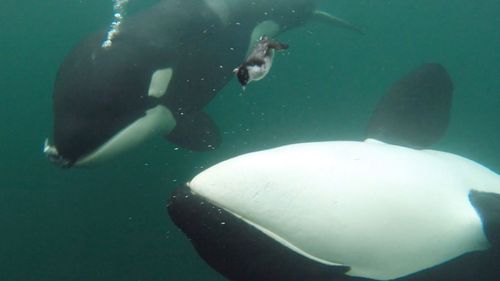Share this @internewscast.com
When researcher Jared Towers set up his cameras underwater to observe a pair of killer whales, he saw something strange.
A young female orca interacted with a camera in the water by bringing over a dead seabird. John Towers, head of Bay Cetology, which is a group of marine experts in Alert Bay, British Columbia, explained to CNN that the orca opened her mouth, allowing the bird to emerge as she observed her surroundings.
After closing her mouth and pausing to see how Towers would react, she stayed in place while the bird floated nearby. Then, moments later, she shifted and took the bird back into her mouth.

A few years on, Towers observed a similar incident involving another young female orca. This time, the whale released a freshly killed harbor seal pup right next to his boat, demonstrating comparable behavior.
Towers discussed these incidents with his colleagues around the world, discovering that they too had been gifted food by killer whales.
When he collated the instances, he found 34 cases of killer whales presenting humans with food between 2004 and 2024.

Perhaps, they hypothesised, the killer whales are curious and exploring how humans will react to a gift.
Maybe they are playing, though they largely discount this theory because whales of all ages, rather than just juveniles, provisioned food.
Or, perhaps it is something more sinister â killer whales have been known to use prey to attract other species and then kill them, but there is no record of orcas ever killing humans in the wild.
“I don’t think it’s easy to suggest there is one reason for this behaviour because there are underlying mechanisms and proximate causes,” Towers said.

“The main underlying mechanism is simply that they can afford to offer us food and the main proximate cause may be that they are doing so as a way to explore and subsequently learn more about us.”
In all but one of the cases documented, the killer whales initially waited for a response from the humans before most of them retrieved the food, though some simply abandoned it and some even tried to gift it again.
The humans ignored the food almost all the time; they took it only four times and in three of those cases, they threw it back into the water afterward.
Pets bring their owners gifts â think of the dead mice or birds that cats leave outside the door â and animals have been observed giving gifts to each other.
But until now, there have been barely any recorded cases of wild predators giving gifts to humans, aside from a few instances of false killer whales â a species of dolphin â and leopard seals offering people food.
“In a way, it’s not surprising, because ⦠everybody who’s on the water with (killer whales) has experienced how inquisitive and curious they are and have had interactions where you know there’s something going on between us and them,” Hanne Strager, a researcher and author who wrote The Killer Whale Journals, who wasn’t involved in the study, told CNN.

No witnesses come forward after town bully murdered
Killer whales are one of the most intelligent animals; only humans have a larger brain relative to their body size, according to the study.
And they kill much larger animals relative to their own body size than other whales and dolphins, meaning they can have more food to share around.
They are also believed to have spindle neurons in their brains â a type of neuron known to be associated with empathy â said Philippa Brakes, a behavioural ecologist at the University of Exeter specialising in whales and dolphins who wasn’t involved in the study.
While she added that determining motivation is difficult “because we can’t interview them,” she suggested to CNN that it could be “altruistic” or just a “basic biological function” mimicking “something you might do to a juvenile.”
The researchers found that it didn’t matter where in the world the whale was or whether it was male or female, a calf, a juvenile or adult â they all displayed this behavior.
It fits into a wider pattern of killer whales often initiating interactions with humans and boats, offering further insight into their lives.
And Towers hopes it serves as a reminder that “while our species is obviously more technologically advanced than any other on the planet, we do share it with other highly evolved species whose welfare must be considered in our actions.”








